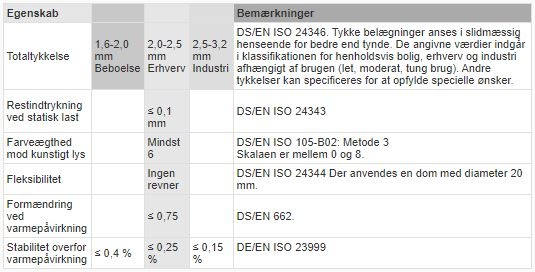- Acoustic panels
- Tailored rugs
- Bamboo floor and boards
- BeefEater gas grill
- Table tops & table legs
- Design floors
- Tiles and clinker
- Good advice on flooring
- Carpets
- Floor heating
- Grass carpets
- Cork floors
- Kitchen, bath & wardrobe
- Laminate floors
- Linoleum floors
- Paint, Tissue & Putty
- Mats
- Needle felt and fair carpets
- Furniture
- Care products
- Remainders & good offers
- Stavparket / Sildebensparket
- Carpet tiles
- Terrace boards
- Accessories
- Wooden floors
- Product samples
- Vinyl flooring
- Tool
- Other products
- Ceiling and wall panels
- Nice floors
- Pine floor
- Click floors
- Ordered goods
-
Hot41% Off
-
Hot46% Off
-
Hot25% Off
-
Hot54% Off
-
Hot54% Off
-
47% Off
Vinyl
All information on this page is copied material from Gulvfakta, which is a technical reference material, Source: Gulvfakta
Vinyl is the colloquial term for PVC, which is short for PolyVinyl Chloride. PVC is a synthetic material with a number of good properties, including making it suitable for floor coverings. In order to achieve the desired properties, various auxiliary materials are added during manufacture, e.g. stabilizers, plasticisers, dyes and possibly fillers. Vinyl coating is often provided with an easy-to-clean and hard-wearing surface protection in the form of polyurethane or equivalent. PVC floor or vinyl floor has incredibly high wear resistance, which is why vinyl is used as a covering in many Danish homes.
1.3.2.1 Introduction
1.3.2.2 Properties
1.3.2.3 Laying and use
1.3.2.4 Wet rooms
1.3.2.5 Cleaning
1.3.2.6 Checklist 3, 4, 5 and 6
All information on this page is copied material from Gulvfakta, which is a technical reference material, Source: Gulvfakta
1.3.2.1 Introduction
A vinyl floor is used in many schools, hospitals, offices, shops, homes, etc. As vinyl floors are easy to clean and can be made waterproof, they are also usable in bathrooms, cleaning rooms, commercial kitchens, laboratories and the like. Vinyl coverings are available in different varieties, each of which is available in many colors and patterns. Some of the product types can also be supplied with embossed surfaces. Vinyl coverings are produced as track products or as tile products. The surface of vinyl is smooth and easy to clean. Vinyl has good resistance to water and most acidic and alkaline materials. Vinyl is also available with a rougher surface for use in places where increased slip resistance is required.
Long-term exposure to oil, asphalt, rubber, etc. can cause dyes to migrate into the vinyl and cause discolouration. Vinyl cannot withstand cigarette flames and certain organic solvents. Vinyl used as a floor covering must be CE marked. CE marking of elastic floor coverings is discussed in the section on CE marking of elastic floor coverings.
Vinyl that is used as a floor covering in escape routes and other areas with requirements for fire and smoke development must have documentation to meet the European fire class Dfl-s1 according to DS/EN 13501-1 (class G floor covering). For all types of classified vinyl, a 5-year wear guarantee is provided in accordance with GSO's rules for material guarantees, provided that the supplier has approved the area of application.
At the floor warehouse, we carry a wide range of vinyl floors for every taste. We have both vinyl flooring in rolls , vinyl flooring with a click system , vinyl for wet rooms , Vinyl Loose Lay and vinyl flooring for gluing . Take a closer look at Amaron vinyl herringbone parquet Preston oak , BiClick vinyl click flooring Monumental Oak or Start classic beech parquet vinyl flooring .
Homogeneous vinyl coatings
Homogeneous vinyl consists of a uniformly colored mass. Any pattern goes through the entire coating. Homogeneous vinyl is available in thicknesses from 1.5 mm to 4.0 mm. It is supplied in strips with widths between 1.2 and 2 m and some are also supplied in the form of tiles, which are available in formats between 250 x 250 mm and 610 x 610 mm.
Homogeneous vinyl can be supplied as an electrostatically dissipative floor covering for use in rooms with requirements for personal discharge. The supplier can provide detailed information on the electrical resistance of the coatings.
Heterogeneous vinyl
Heterogeneous vinyl consists of a wear layer and other compact layers, which can vary in composition and pattern. The coating may contain reinforcement.
Heterogeneous vinyl can be supplied as an electrostatically dissipative floor covering.
Vinyl with increased slip resistance
Vinyl with increased slip resistance contains quartz grains, aluminum grains or the like, which can be in the surface or throughout the coating thickness. The classification for different areas of use is based on a wear test carried out in accordance with DS/EN 13845. Depending on the particle loss, which must not amount to more than 10% after 20, 30, 40 or 50,000 rotations respectively, the coatings can be classified as residential, commercial or industrial use. The slip resistance is tested on a wet test ramp according to DS/EN 13845, where a test subject moves forward and backward while the slope of the ramp is gradually increased until it reaches an angle of 45°. The slip resistance is determined partly with footwear (ESf), where the slope of the ramp must be greater than 20° before the subject steps, and partly as a barefoot test (ESb), where the slope achieved must be greater than 15°.
Insufficient or incorrect cleaning and care - including the use of unsuitable cleaning and care products - will reduce the floor's slip resistance. You can find more information about test methods etc. in the section about slip resistance. Cushion-vinyl are multi-layer coverings, which have a wear layer of clear PVC on top and a layer of foamed PVC material with a printed pattern in the middle. At the bottom, a stabilization layer, which can additionally be provided with a glass fiber or mineral fiber reinforcement.
Cushion vinyl is supplied as a track product in widths from approx. 1.8 m to 4.0 m. Thicknesses up to 5 mm.
Cushion vinyl is primarily used in the residential sector. In the object sector (business sector) cushion vinyl should only be used in consultation with the supplier.

Vinyl with foam or cork backing
These products consist of a base of foam or cork, over which there is a vinyl wear layer. Vinyl with a base of foam or cork is available in many different qualities. They are supplied in thicknesses from approx. 2.5 - 6.5 mm and in widths from approx. 1.2 to 2.0 m. Vinyl with foam or cork backing is used in the residential sector, schools, hospitals, offices, shops, sports halls etc.
Quartz vinyl
• Quartz vinyl is made from PVC with a large content of fillers, especially quartz. This results in the coating being durable against heavy traffic and more open to water vapor diffusion than other types of vinyl coatings. Quartz vinyl is supplied as tiles in the formats 300 x 300 mm or 600 x 600 mm and in thicknesses of 2.0 to 3.2 mm.
• Quartz vinyl is primarily used in the object sector, where great durability against heavy loads is required, eg supermarkets, warehouses, shops, meeting rooms, etc. Gluing of quartz vinyl must be done in accordance with the glue supplier's instructions.
• Quartz vinyl cannot be made waterproof and therefore cannot be used in wet rooms.
1.3.2.2 Properties
Products that meet the European standard DS/EN 10581 must comply with specific requirements for:
• Length, width, straightness and surface weight
• Dimensional stability and shape stability after heat exposure
• Thickness, flexibility and resistance to indentation marks
• Color fastness to artificial light.
If vinyl is used that is not EN-classified (cushion vinyl, vinyl with a foam or cork backing), the designer must ensure that the coating has the relevant properties. EN rated vinyl coverings have slightly different deviating specifications depending on the type. This is evident from the respective standards: DS/EN 10595, semi-flexible PVC tiles and DS/EN 650, PVC floor coverings with felt backing etc.
In addition to the properties included in the classification, there will often be a need to set requirements for other properties, depending on the current application. These properties are part of the Floor Industry's supplementary properties, which for vinyl include:
Requirements for the place of execution
Time must be set aside for the vinyl to acclimatise. Acclimatization is best done by laying out the tracks loosely over the floor after cutting. Optionally, the cut strips can be placed vertically after cutting in a loosely rolled form. Tiles are placed in unopened packaging in the room where they are to be used. Acclimatization must last at least 24 hours. Even after long storage in the building, a packaged roll cannot be expected to be in moisture equilibrium with the surroundings.
During and after gluing vinyl, the temperature in the air and the subfloor must be 17-25°C and the humidity between 35%-75% RH. The substrate must have the same flatness as required by the finished floor, normally ± 2 mm on a 2 m straight log. Flatness and floors, including requirements and measurement methods, are described in the section flatness and floors. If the vinyl is to be laid directly on cast decks, the concrete's pore moisture (residual building moisture) must be no more than 85% RH (for quartz vinyl tiles, however, no more than 90% RH). Moisture and floors, including requirements and measurement methods, are also described in the section on building moisture
There must not be strong drafts or strong sunlight during the laying of the floor.
1.3.2.3 Laying and use
Conditions in connection with laying and use
Correct free cutting in track joints is important, as the glue joint in the first part of the glue's curing phase will not be able to hold the coating to the substrate if compression occurs in the joint. The supplier's instructions on the execution of additions and cuts must be followed.
Vinyl can either be laid with butted joints, which is often used when laying patterns, or by welding the joints. Close cutting to vertical surfaces is not possible. Therefore, it will be necessary to fit strips if you do not want a visible joint along the floor. Laying the vinyl must be done within a certain time after the glue has been applied (the installation time), to ensure good adhesion and thus the best adhesion. The installation time depends on the materials to be glued together and on the humidity and temperature conditions in the room.
Welding
Vinyl floors that are exposed to water, e.g. in bathrooms, must be welded in the track joints. For welding track joints, welding wire specified by the supplier is used. Welding must not be carried out until the glue has sufficiently hardened. After welding, the wire must be cut off at level with the surface of the webs, so that cleaning water and dirt do not collect in and around the weld joint. Weld joints must appear smooth and uniform.
Electrostatic dissipative floors
Homogeneous and heterogeneous vinyl coverings are suitable as conductive floor coverings and can be used in rooms where there is a need for the dissipation of electrical charges. Electrostatically dissipative vinyl floors are made using a dissipative vinyl coating. The floor must also be connected to the ground through copper bands. It must be agreed where the flooring contractor must run the copper strip up the wall.
Installation of electrostatically dissipative vinyl floors must be carried out in consultation with the coating supplier. Grounding must be carried out by an authorized electrical installer. Statically dissipative and statically conductive elastic floor coverings - concepts, requirements etc
1.3.2.4 Wet rooms
Homogeneous and heterogeneous vinyl coatings with documentation to meet special quality requirements can be used as a waterproof coating for floors and walls in wet rooms. Cladding with PVC in wet rooms is described in Wet Room Facts, which is published by Gulvbranchens Våroomskontrol and Byg og Byg Anvisning 200, which is published by the Norwegian Building Research Institute.
1.3.2.5 Cleaning
The future users must be informed about correct cleaning, as incorrect cleaning can cause damage to the surface. The supplier's instructions on cleaning and maintenance of vinyl floors must be given to the user. Dry methods are preferably used for daily cleaning, i.e. dry or wet mopping or vacuuming and washing as required. For stronger, occasional cleaning, use a universal cleaner or washing/care product. In areas where extensive wet cleaning is required, track joints must be welded. Cleaning vinyl floors is discussed in the section on cleaning.
1.3.2.6 Checklist 3, 4, 5 and 6
Checklist 3. Properties included in the EN classification for homogeneous and heterogeneous vinyl floor coverings. The classification is based on the total thickness and the thickness of the wear layer. For classes Business and Industry, weld seams in the covering have a strength of over 240 N/50 mm, and for Business Moderate and higher, the coverings are suitable for use with office chair wheels. Other properties comply with the marked values for EN-classified products.
Checklist 4. Supplementary properties for homogeneous and heterogeneous vinyl coverings, which may need to be specified, e.g. due to special effects on the floor during the current use.
(*) In escape routes, wall cladding must be class K1 10B-s1,d0 according to DS/EN 13501-1. Refer to the suppliers and DBi for further information.
Checklist 5. Properties included in the EN classification for semi-flexible vinyl tiles. The classification is based on the total thickness and the thickness of the wear layer. Other properties comply with the marked values for EN-classified products.
Checklist 6. Additional properties for semi-flexible vinyl tiles, which may need to be specified, e.g. due to special effects on the floor during the current use.










